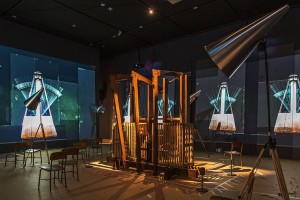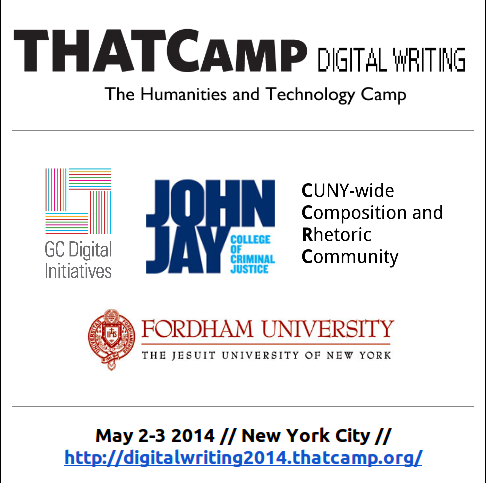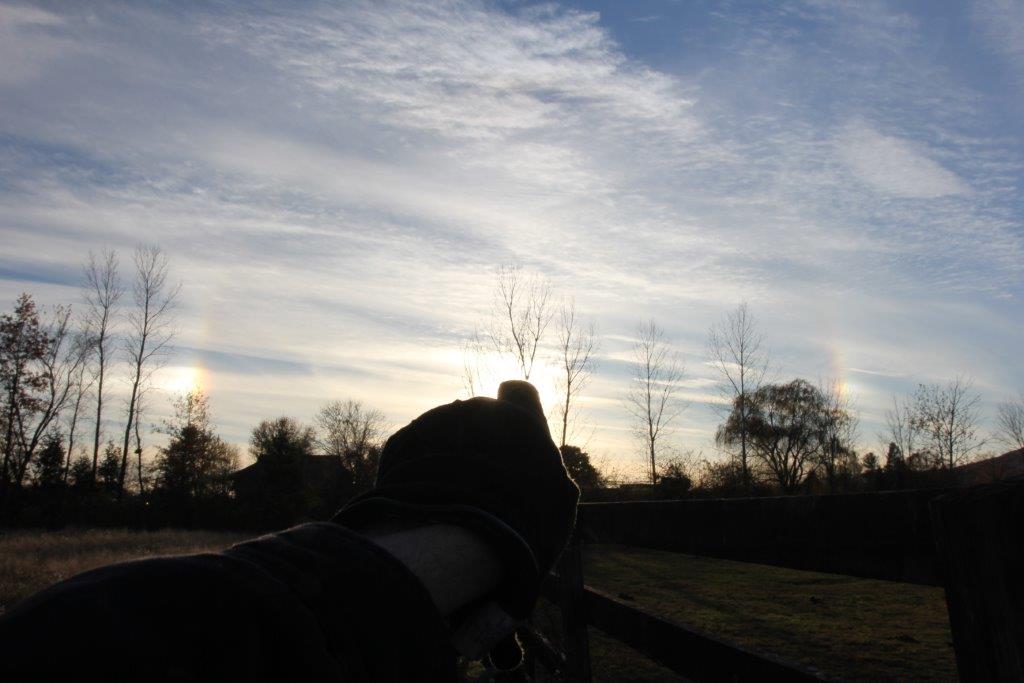
The Metropolitan Museum of Art, New York
When Einstein’s theory of relativity first became known to the world in the early 1920s, there was an outpouring of attempts in 1921 by the print media, literary writers, artists and others to understand the theory and think about its meaning not only for science, but the everyday world. There were many reasons for the widespread response, but one journalist summed it up pretty well: Einstein has “quickened our imaginations so that we leap upon a ray of light, escaping time.”[2]
Since then, artists–visual ones, as well as writers and musicians–have used image, word, and sound to imagine what spacetime looks and feels like.[1] Artists have not only been inspired to use their chosen art form to understand spacetime, in some cases, it has influenced the shape of their art work. It has also led artists to combine their art with Einstein’s essential concepts about time and space to reflect reality and understand the world itself.
Whether those artistic responses are scientifically correct is beside the point. What’s important is how artists draw from the theory to inspire their art.
Einstein would, of course, caution us to remember that only mathematical concepts adequately describe the theory of relativity. In a letter he wrote in 1946 to Paul Laporte, an aspiring art critic who compared Cubism to the theory of relativity, Einstein explained that although both disciplines strive to create an “order” that results in “distinctness and clarity,” order in scientific principles and theories is “achieved through logical connection,” whereas the “principle of order” in art is “anchored in the unconscious.”[3]
Certainly a work of art gives ideas shape, voice and meaning to emotion and subjectivity anchored in the subconscious, or unconscious, as Einstein put it. But art, like science, helps us make sense of the world. To do that, artists must often draw from the real, wide awake world for their inspiration and raw material.
Consider, for example, William Kentridge’s The Refusal of Time (2012), an installation that exhibited at the Metropolitan Museum of Art in New York City in 2014. The Refusal of Time is a wonderful of example of an art work that incorporates visual media with words and sound to imagine what spacetime feels like. Spacetime’s concepts also contribute to the installation’s look and feel, and Kentridge uses spacetime to make sense of linear time and history and oppression–particularly as they pertain to Apartheid in South Africa. Such big topics need an entire gallery to accommodate their expression:
You enter the darkened room, which might just recall Plato’s cave, and sit in one of the several old, child-sized, wooden school chairs distributed randomly around. In the center of the room to your left, a seven or eight-foot high machine, called an elephant, mechanically huffs and puffs its metal parts in and out of its rectangular wooden cage. The machine reminds you of a bellows or a mechanical heart.
The darkness breaks when a video of a larger-than-life metronome appears on the west wall. The metronome’s thin metal tongue falls to the right and then left side of the wooden, pyramid-shaped body, making a loud clack each time it reverses direction.
The clack gets louder when four more metronomes appear: two on the north wall, two on the south, all ticking in sync. A couple of the metronomes are difficult to see because the bellows-like machine partially blocks your view of the southwest wall. You can’t move your chair for better view because the chair is bolted to the floor.
Then one metronome falls out of sync, and another. Some move at high speed, some awfully slow, and at least one moves so fast it appears to be motionless in time and space. Another ticks at a regular quarter-note pace. The ticking sounds crazy and random, as though there are many more than five metronomes. But if one metronome could be isolated from the rest, its rhythm would be a simple, clean, clack, clack.
To be sure, my description of the first few minutes of the exhibit does not do justice to the juxtaposition of sound, sculpture, animation, and video that make up The Refusal of Time. But the opening provides crucial keys for understanding Kentridge’s intepretation of spacetime in the physical installation and the video component.
Spacetime fascinates artists in part because at its heart lies the claim that there is no past or future, just the present. As Brian Greene explains in the Elegant Universe, all moments, all events that have occurred or will occur are in fact, occurring now, all at the same time. Linear time, on the other hand, is a construction. It’s a powerful illusion that seems as real and incontrovertible as the materiality of the clocks and calendars humans created to measure it. The great irony, if not disappointment, is that humans cannot consciously experience spacetime. Our physical limitations allow us to only experience time as linear. We must live with the knowledge that our forward-moving lives, this thing we call reality is, in some respects, illusory. Art steps in to feed our imagination so we can see past that illusion.
In Kentridge’s vision of spacetime, the ticking metronomes and the huffing elephant-like machine are both material representations of linear time and symbolic of it. Their presence suggests we cannot understand spacetime without referencing our deep awareness of linear of time and the sense that this awareness is nearly impossible to escape—the proverbial elephant in the spacetime room, so to speak. The elephant machine, in fact, is a model of one proposed in the 1870s to “pump regular bursts of air to calibrate” the clocks of Paris, and it is described in Peter Galison’s book Einstein’s Clocks, Poincare’s Maps.[4] (Galison advised Kentridge on the project and he is listed as its dramaturge.)
To be sure, the metronomes are not clocks. But they do measure meter in music—the time it takes for a note sound—and their constructed nature and ticking are strongly suggestive of a physical clock and the passage of time it measures. At the same time, the metronome’s loud ticking sound occurs in a space absent of any visual clock face. Thus time becomes an abstraction, and specific moments in time are detached from any concrete point on a clock.
The five asynchronously ticking metronomes remind us that what we perceive as being “right now” is only one now of countless others. Here again is where our humanness comes into play, preventing us from seeing through the illusion of linear time. Even though all Nows co-exist, we can only experience our unique, particular, linear feeling of “right now,” a moment trapped between a lost past and an unlived future. We are blocked from the full view because we exist inside of spacetime. The elephant-like machine that blocks our view of some of the metronomes reminds us that we cannot stand outside of spacetime and see it whole or see past the powerful illusion of linear time.
In other words, we cannot stand outside of space and time to see all the co-existing Nows of being born, living, and dying. Where we are in space determines where we are in time. When we look at the stars, we’re seeing an earlier version of them; similarly, people on another planet see an earth much younger than the one we live in today. If they had a telescope that was powerful enough, they might see the emergence of Apartheid in South Africa, though from our perspective today, Apartheid ended several years ago. The moment we see or experience depends on where we are when the light with that information reaches us.
The Refusal of Time refuses linear time in favor of interpreting the world under the terms of spacetime, as seen when figures engaged in repetitive actions replace the metronomes. For example, across the five video channels, we watch five different versions of a man who walks a few steps and then steps onto and off a stool, over and over again. In another scene, we watch five versions of a turbaned woman seeing her husband off to work through one door and then welcoming in her lover through another. Each video channel gives us a different perspective of the scene, yet there is the pervasive sense that all these scenes are happening at the same time, and that each one represents a Now that does not vanish into yesterday but is ongoing.
Yet another set of videos shows a time bomb in various states of construction and post-apocalyptic fall out. The words “Give me back the sun” appear and disappear (a reference, no doubt to Plato’s Analogy of the Sun). At another point, the names of important wars and battles in Africa flicker across the screen. Their names differ, but the sense is that each gunshot and death caused by war and oppression happen over and over again, not unlike the metronomes or the man stepping on and off a stool. Every event that has ever happened or will happen is inevitable, not random, ongoing, and present.
Toward the end of the 30-minute video, silhouetted figures in the movie march by in a parade-like funeral procession. They carry a tuba, a bathtub, and other objects that eventually degrade to burnt-out remnants. The video portion of the exhibit concludes with the turbaned woman dancing with a figure that symbolizes the sun–possibly a representation of goodness and enlightened thought.
In reflecting Einstein’s notion that moments are never past but always now, these scenes suggest that even though tragedies such as war have ended from our limited, linear point of view, from the perspective of spacetime these moments of strife continue. By the same token and the note upon which The Refusal of Time concludes—with the woman and sun dancing together—there is the reminder that oppression and war are not the only Nows to coexist, but that the universe also harbors all our moments of happiness and joy, as well. In terms of Plato’s Allegory of the Cave, if we can be free of the shadow of linear time, we will be that much closer to seeing the true form of reality.
In a description of the exhibition posted by Institute of Contemporary Art in Boston, Kentridge writes that he did not “want to use ‘science as a backdrop’ nor to employ ‘art as illustration of science.’ Rather he wanted ‘something more elusive: an intensification of our encounter with time.’”[5] Surely he has succeeded. The Refusal of Time does deepen our understanding of spacetime, and it also gives a new way to think about the past and the present, about tragedy and joy.
Since the past is never really past, we know that oppression always occurs somewhere and sometime, even though our perspective may at times be too limited to see it. Similarly, when we are faced with personal grief and tragedy, we can take some comfort in the fact that happier moments we consider to be in the “past,” haven’t really passed, either.
The Refusal of Time refuses a past that is lost and a future that is yet to be and embraces the present as one moment among many. Much as linear and nonlinear hang in the balance, so do joy and suffering. In times of great grief, we may take comfort in knowing that nothing is ever truly lost, but exists out there, somewhere in the universe. Like the turbaned woman and her dancing partner, the sun, we are dancing in some now, in some place.
—–
[1] Artists and writers include artists Wassily Kandinsky and Pablo Picasso, composer Igor Stravinsky, poets William Carlos Williams and E. E. Cummings. For resources about the relationship of artists to the theory of relativity, see “Perception is Reality: The Theory of Relativity in Art.” Parrish Co. June 12, 2007. Weblog; Alan J. Friedman and Carol C. Donley. Einstein as Myth and Muse. New York: Cambridge UP, 1985; Arthur I. Miller. Einstein, Picasso: Space, Time, and the Beauty That Causes Havoc. New York: Basic, 2001. Print; Leonard Shlain. Art and Physics: Parallel Visions in Space, Time and Light. New York: Perennial, 1991. Print.
[2] Gertrude Besse King. “Aladdin Einstein.” The Freeman 27 April 1921. Print. P.153.
[3] Paul M. Laporte. “Cubism and Relativity with a Letter of Albert Einstein.” Leonardo. 21.3 (1988): 313.
[4] “William Kentridge: The Refusal of Time.” Exhibitions. Metropolitan Museum of Art. 2013. Web page.
[5] “William Kentridge: The Refusal of Time.” Exhibitions. Institute of Contemporary Art/Boston. 2013. Web page.





You must be logged in to post a comment.